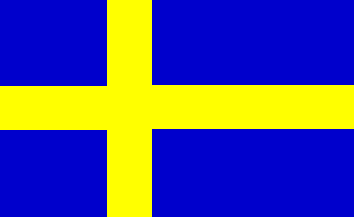 |
SWEDEN |
Part 6 |
Thursday 25 June 2009
Gävle - Stockholm: 170km / 106
We set course for Stockholm.
It is a good 2 hours' 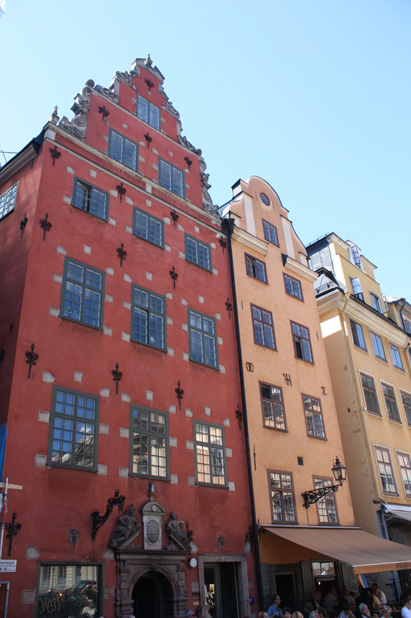 drive
to the capital. With help of our SatNav we find our way through the heavy
traffic without much trouble. The youth hostel Zinkensdamm
is on the island of Södermalm. We check in and bring our bags to our room. It
is a fine room with its own shower and toilet. as well as internet hook up. We
drive back into the centre to bring back our car at Avis on
Vasagatan, across from the Central Railway Station. We buy a 72 hour public
transport ticket for 200 kronor and take the underground to the old town. We
have lunch at one of the street tables of a small lunch restaurant. The weather
is excellent again. We walk into the old quarters and I relive old memories from
the time that I lived and worked here as an intern.
drive
to the capital. With help of our SatNav we find our way through the heavy
traffic without much trouble. The youth hostel Zinkensdamm
is on the island of Södermalm. We check in and bring our bags to our room. It
is a fine room with its own shower and toilet. as well as internet hook up. We
drive back into the centre to bring back our car at Avis on
Vasagatan, across from the Central Railway Station. We buy a 72 hour public
transport ticket for 200 kronor and take the underground to the old town. We
have lunch at one of the street tables of a small lunch restaurant. The weather
is excellent again. We walk into the old quarters and I relive old memories from
the time that I lived and worked here as an intern.
We arrive on the grand market square and
move onto the Royal palace.
The present palace was completed in 1754 occupies the spot of the old Three
Crown Castle, that burned to the ground in 1697. It was designed by the
architect Tessin the Younger. We have coffee on the inner court yard and buy
tickets for a visit of the Royal Apparments. An guided tour in English leaves at
2pm. We meet the guide in the State Hall, where the king used to open the
parliamentary year. Here is also the Silver Throne of Queen Kristina
(1626-89). These days the king goes to parliament at the start of the
parliamentary session. The Hall is still used for official occasions. The tour
that follows takes us to the Order Room, devoted to a a number of Royal Orders
the Swedish Court holds. There is a shield for every living member of the Orders
on the wall. If a Knight dies his shield is moved to the Riddarholm Church. We
continue the tour to the Royal Appartments on the second floor of the palace
which were decorated mostly by king Gustav III. This 18th century king
centralised government, drew all power to himself and introduced all kinds of
French court traditions, which humiliated and marginalised the nobility. This
caused his death. During an opera ball he was shot and died soon after. We see
the former dining room - now the room where the king meets the cabinet - , the
saloons and sleeping quarters of the king and the queen and the gallerie between
them.
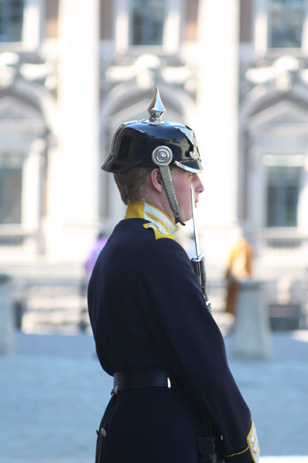 This gallery is now used for state dinners. It used to be the rule that a royal
dinner was ended as soon as the king had finished his plate. The king was served
first and started eating immediately. Gustav V was a fast eater, so it often
happened that dinner was over before everyone had got their plate.
Etiquette is more relaxed these days, but at 11pm the king calls it a day and
everyone has to go home. The royal couple does not live here anymore since 1981.
They moved to
Drottningholm outside the city centre. In 1999 king Carl XVI Gustav, came with
the idea of holding a disco party at the palace during the millennium
celebration. In order to test if the 250 year old palace floor would sustain a
party, groups of soldiers had to march up and down the hall, while technicians
monitored the construction. The palace was fit enough and the party took place
on new year's eve 1999.
This gallery is now used for state dinners. It used to be the rule that a royal
dinner was ended as soon as the king had finished his plate. The king was served
first and started eating immediately. Gustav V was a fast eater, so it often
happened that dinner was over before everyone had got their plate.
Etiquette is more relaxed these days, but at 11pm the king calls it a day and
everyone has to go home. The royal couple does not live here anymore since 1981.
They moved to
Drottningholm outside the city centre. In 1999 king Carl XVI Gustav, came with
the idea of holding a disco party at the palace during the millennium
celebration. In order to test if the 250 year old palace floor would sustain a
party, groups of soldiers had to march up and down the hall, while technicians
monitored the construction. The palace was fit enough and the party took place
on new year's eve 1999.
After the tour we go out and have a drink at the Market Square café Chokladkoppen, in the old town. It is the gay café of the old town. From there we walk to the Cornelis Vreeswijkmuseum, a hundred yards from the square. Cornelis Vreeswijk (1937-87) is a singer of Dutch origin, who emigrated with his parents to Sweden in 1948. When his parents returned to the Netherlands he stayed on and started a career as singer and song writer. He became extremely popular with his songs. - August 2nd is Cornelis Vreeswijk Day - that draw on blues and Swedish folk music. The Vreeswijk foundation manages a museum in the heart of Stockholm, that is free of charge displaying manuscripts, posters, guitars and albums. Also back home in the Netherlands Vreeswijk had some success during the 1970s with songs translated into Dutch. His greatest success both in Sweden and the Netherlands was "Veronica".
We take the underground back to the youth hostel. From the train we see lots of Stockholmers sunbathing on the quay near Kornhamnstorg - a new phenomenon to me. In the evening we go visit my old friend Martin and his family, who has moved out to the suburbs near the coast. We take the underground to Slussen and from there the bus to Nacka. It is a 20 minute journey. Marting comes to meet us at the bus stop with his youngest son. It is a pleasant evening. We have a BBQ and play with his two sons. We talk about old and news with Martin and Katarina on their veranda. We take the bus back around 10.30pm
Weather: sunny and warm, 25ºC / 77ºF
Friday 26 June 2009
We take the underground (Tunnelbana) to
the old town. We start the day with a coffee at the outside tables of Chokladkoppen
on Stortorget. We then take the underground to Ropsten, where we change to 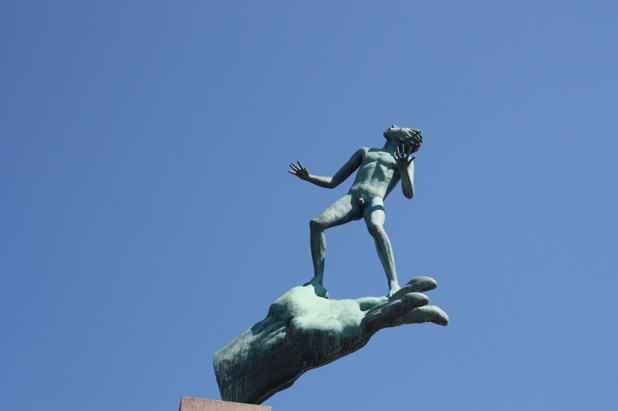 Lidingöbanan. That is an old tram that takes us over the the bridge to the
island of Lidingö.
We get off after two stops and walk to the Carl
Millesgården. That is the house of the sculptor Carl Milles
(1875-1955), beautifully situated on a mountain overlooking the city and harbour.
Milles was a productive artitst, who made small and large bronze statues, most
of them were put on display in public spaces in Sweden. The garden of the house
is made into a sculpture gallery full of copies and models of Milles work. In
his lifetime he was already busy to convert his house into an art garden for the
public. On certain days he would open the gates for those who were interested in
his work. At his death he bequeathed the house and garden to “Swedish
people”. On the grounds is also a lunch café, where we have lunch with a view
over the city.
Lidingöbanan. That is an old tram that takes us over the the bridge to the
island of Lidingö.
We get off after two stops and walk to the Carl
Millesgården. That is the house of the sculptor Carl Milles
(1875-1955), beautifully situated on a mountain overlooking the city and harbour.
Milles was a productive artitst, who made small and large bronze statues, most
of them were put on display in public spaces in Sweden. The garden of the house
is made into a sculpture gallery full of copies and models of Milles work. In
his lifetime he was already busy to convert his house into an art garden for the
public. On certain days he would open the gates for those who were interested in
his work. At his death he bequeathed the house and garden to “Swedish
people”. On the grounds is also a lunch café, where we have lunch with a view
over the city.
We take the underground back to Gamla Stan
(Old Town) and leave the station at the rear side and walk to Riddarholmen
island, where we visit theRiddarholmchruch
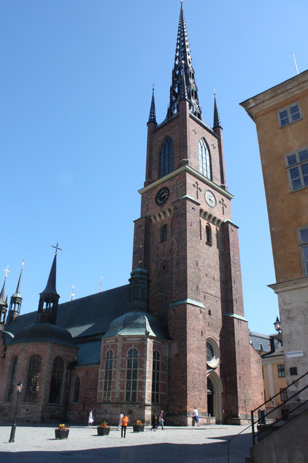 . In this church king Gustav II Adolf (d. 1632) started the tradition of Royal
Burials and a mausoleum. At this very spot was the burial place Magnus Ladelås (d. 1290),
one of the medieval kings of the Svear people.
All kings since Gustaf II Adolf lie here, with the exception of Queen Kristina (1626-89),
who converted to - thus shaming the Swedish Royal family - Catholicism, stepped
down as Queen and moved to Rome. We see many sarcophaguses of former kings
and their consorts, but also shields for prominent persons who earned a Swedish
knighthood, but have died. The shields of the living knights are in the
Order Hall at the royal palace. Among the dead knights are also the Dutch Queens
Wilhelmina (1898-1962) and Juliana (1909-2004), but also the likes of François
Mitterrand.
. In this church king Gustav II Adolf (d. 1632) started the tradition of Royal
Burials and a mausoleum. At this very spot was the burial place Magnus Ladelås (d. 1290),
one of the medieval kings of the Svear people.
All kings since Gustaf II Adolf lie here, with the exception of Queen Kristina (1626-89),
who converted to - thus shaming the Swedish Royal family - Catholicism, stepped
down as Queen and moved to Rome. We see many sarcophaguses of former kings
and their consorts, but also shields for prominent persons who earned a Swedish
knighthood, but have died. The shields of the living knights are in the
Order Hall at the royal palace. Among the dead knights are also the Dutch Queens
Wilhelmina (1898-1962) and Juliana (1909-2004), but also the likes of François
Mitterrand.
We take the underground again to
T-centralen the central hub of the Stockholm underground network.  From there we walk to NK-department
store, the largest and finest of Scandinavië. We have to control
ourselves but we still tempted to some serious shopping.
From there we walk to NK-department
store, the largest and finest of Scandinavië. We have to control
ourselves but we still tempted to some serious shopping.
Early evening we go out for a lovely cocktail on the outside tables of Grödan in Grev Turegatan, not far from the Östermalmtorg underground station. After that we have dinner at Pontus! on Brunnsgatan, a short walk from Grödan. A very trendy restaurant where have a great dinner with view on the kitchen. Most dishes can be ordered as starter or as a main course. That is up to you. The wines are extremely expensive so we stick to a glass of red wine from South Africa.
After dinner we go to Torget bar on Mällartorget square in Gamla Stan,one of the gay bars in the city. There are quite a number of people still having dinner. The atmosphere is very laid back.
We head back to the hostel, watch some tv and go to bed..
Weather: sunny and warm, 24ºC / 75ºF
Saturday 27 June 2009
After breakfast we drink coffee nearby at bakery shop on Hornsgatan. Erik goes for a haircut across the street. We walk back to the youth hostel, pack our things and take a seat in front of the hostel and wait for our taxi. It comes promptly at noon and takes us to the Central Railway station. Here we get on the Arlanda Express. I bought the tickets online and the credit card I used for paying for them functions as a ticket. With 200km/h (124 mi/h) we speed towards the airport Arlanda. We have already checked in, but do not seem to be not the only ones to have done so and there is a long line for the baggage drop-off counter. Fortunately it does not take too much time and we can move on and have a snack. The KLM flight leaves nearly on time and we land around 5pm in Amsterdam. We catch the 5.45 train for Rotterdam and around 7pm we are back home. End of trip.
Weather: sunny, 23ºC / 73ºF
| |
Other Travel |
| back |
